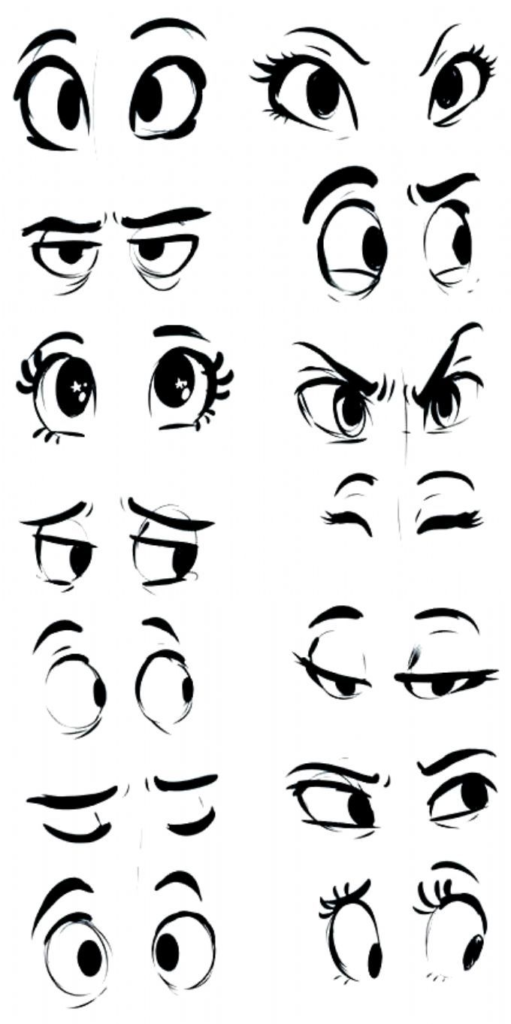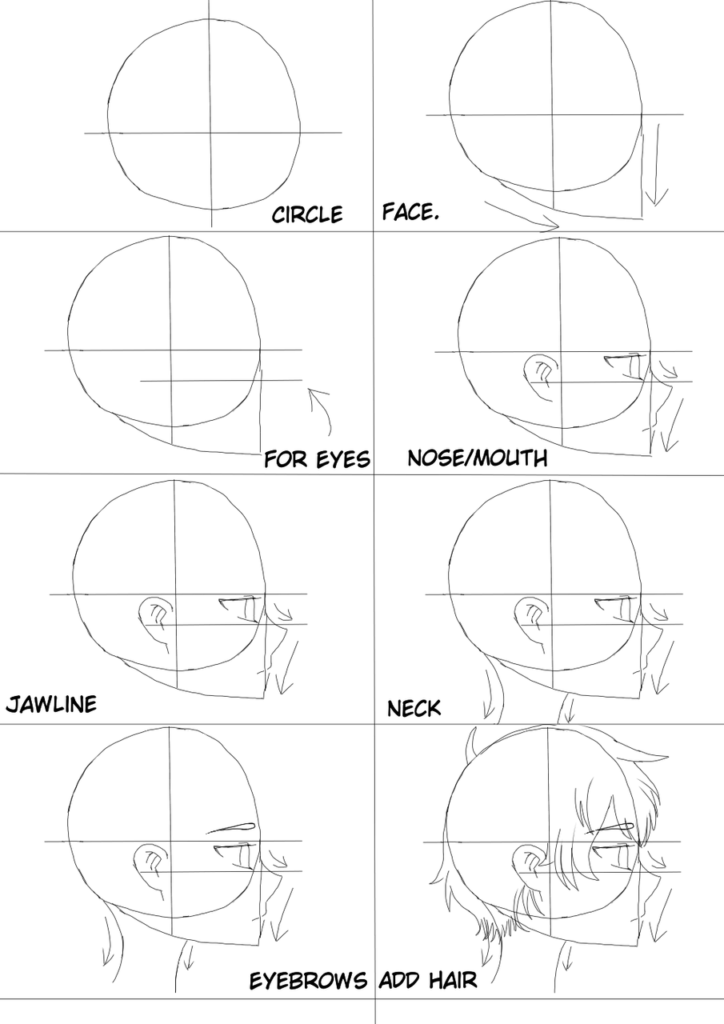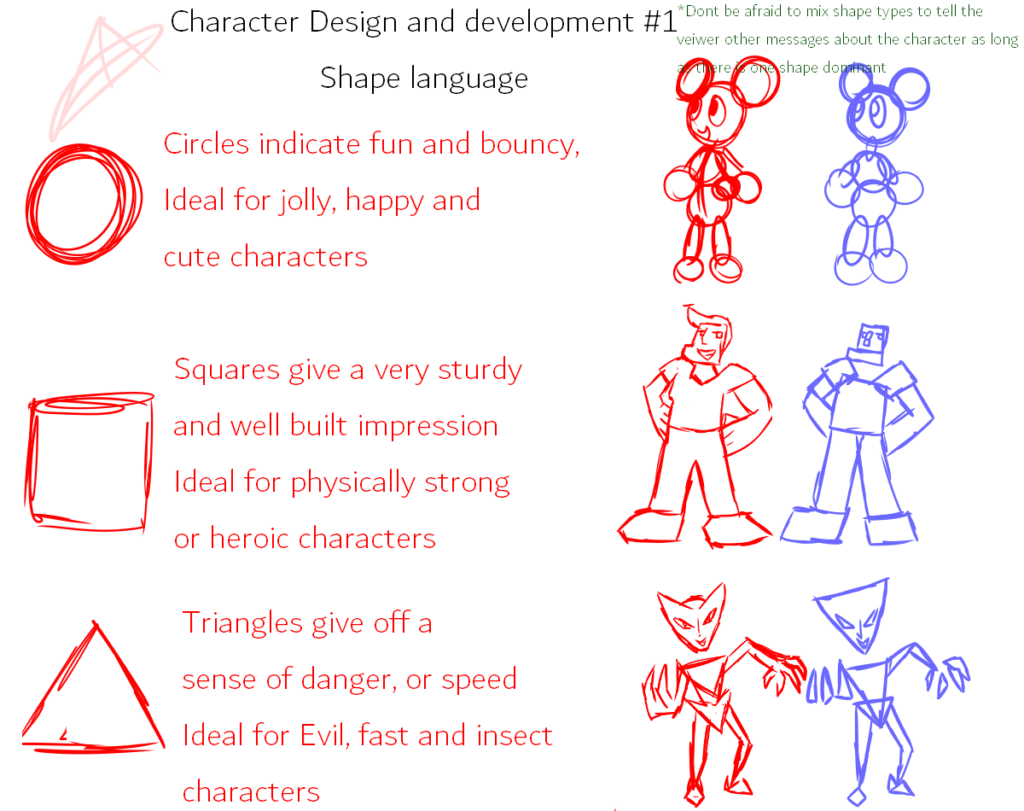Designing The Character
It is crucial to determine who a character is and how the viewers should feel before developing their appearance.
Character Traits: When it comes to character traits, it is a good idea for designers to jot down 3 to 5 adjectives that sum up what they want the audience to feel when they see the character.
Showcasing the Traits: Now is the time to consider and develop ways for the character’s aesthetics to represent who they are.
Eyes: “Eyes are the gateway to the soul,” as the saying goes, and the form of a person’s eyes can reveal a lot about them. A furious soul is represented by a furrowed forehead, whereas pronounced laugh lines represent a joyous spirit. Eyebrow forms can tell a lot about a person’s personality.
 Jawline:
Jawline: A character with a strong jawline might convey to the viewer that they are aggressive, rugged, and confident. Softer jawlines, on the other hand, express feelings of youth and friendliness.
 Nose Shape:
Nose Shape: Characters’ noses come in a variety of shapes and sizes. A nose that is hooked or crooked suggests a secret background or a malicious schemer. Characters with small button noses are charming, childlike, and innocent. Strong, angular noses are ideal for characters who are self-assured or tough.
 Ears:
Ears: Ears can depict otherworldly creatures such as elves or orcs. They can also be adorned with jewelry that reveals information about the wearer. For example, someone who wears magnificent traditional earrings could be a member of royalty. On the other side, rough metalwork earrings could be worn by characters who are more misunderstood.

Shape Theory
Circles, squares, and triangles are the three fundamental shapes that you can use to design characters. To the subconscious mind, each form has a meaning. This shape language runs throughout the figure, from the character’s basic body shapes to details like their eyes or ears.
Circles: Characters with the words soft, sweet, kind, gentle, open, accessible, honest, caring, young, innocent, unsuspecting, unsure, worldly, nature-driven, etc., can be represented by circles.
Squares: Strong, confident, trustworthy, cocky, boisterous, action-oriented, driven, forceful, devoted, arrogant, dependable, even-tempered characters can all be represented by squares.
Triangles: Triangles can be used for villains, but you can also use them for people who are quick, calculating, clever, hot-headed, rogue-like, stealthy, emotional, loving, quick-thinker, slick, graceful, and so on.

Start Designing In 3D
Character designers now have a reference library, have understood the fundamentals of design theory, and have studied the fundamentals of sculpting. Therefore it is time to consider producing the character’s concept art.
That indicates the design is nearing completion and will soon be available in Autodesk Maya, the industry standard for creating TV shows, games, and movies. Maya has been used to produce both charming and stylish characters, as well as more photo-realistic characters. In addition, Maya’s distinct modeling pipeline enables artists to create whatever picture they can imagine.

Model Sheets
A model sheet is also known as a character board, character sheet, character study, or simply a study in the visual arts. It is a document used to assist and standardize a character’s appearance, poses, and movements in mediums such as animation, comics, and video games. When numerous artists create an animated film, game, or comic, model sheets are required to help preserve character continuity from scene to scene. A single animator may only work on one of the hundreds of shots necessary to finish a feature film in animation. An off-model refers to a character who is not drawn according to the production’s standardized model.
Purpose
In the past, model sheets were also employed to maintain visual continuity for long-running cartoon productions of short features, such as the Looney Tunes or Merrie Melodies series. Model sheets are posed cartoon or comic strip characters. They serve as a reference template for several artists working on a long or multiple-edition work of art such as a comic book, animated film, or television series. Model sheets often show the character’s head and body from various angles and sketches of the character’s hands and feet and various fundamental facial expressions.
Model sheets ensure that, despite the efforts of several or more artists, their work is cohesive, as if a single artist did the drawings. They depict the structure, proportions, clothes, and body language of the character. To show a character’s deeper emotional and physical expressions, many pages are required. Deviations from the model may be allowed in the final animation depending on the whims of the animation director. This “tightness” of the model is a crucial distinguishing feature in the overall animation style, as it represents a balance between expressiveness and smoothness/consistency. As a result, model utilization varies greatly between studios and projects. Model sheets are also helpful for making costumes and sculpted miniatures.
Specific Annotations
Model papers also include suggestions on creating specific character elements, such as their head shape, hair length and style, and the size and position of their eyes and mouth.
Examples: Some model sheets are dedicated to specific completed or continuing projects, while others are broader and cover the whole character library of a company. Aside from Disney, other animation studios and enthusiasts also offer model sheets on their websites. However, to present the notion of model sheets, Larry’s Toon Institute presents a generic model sheet.
Copyright And Fair Use
Model sheets are often copyrighted content owned by the animation studio that generated customizing rather than putting it out in the public domain. Model sheets are designed for artists who work for the studios that control the characters. These templates are created for the same purpose. Also, other artists, such as fan artists, benefit from them by customizing the characters according to their colors.
Conclusion
Character design is essential. Characters are more than just a visual depiction of a concept or a mascot that promotes a product or a study. In reality, well-crafted characters have personality and charm, which draws viewers into your style of storytelling. However, creating a likable character that will pull people in and stimulate their interest in your product, website, or presentation is a difficult task. To make it happen, character design necessitates a great deal of knowledge and ingenuity.
 Jawline: A character with a strong jawline might convey to the viewer that they are aggressive, rugged, and confident. Softer jawlines, on the other hand, express feelings of youth and friendliness.
Jawline: A character with a strong jawline might convey to the viewer that they are aggressive, rugged, and confident. Softer jawlines, on the other hand, express feelings of youth and friendliness.
 Nose Shape: Characters’ noses come in a variety of shapes and sizes. A nose that is hooked or crooked suggests a secret background or a malicious schemer. Characters with small button noses are charming, childlike, and innocent. Strong, angular noses are ideal for characters who are self-assured or tough.
Nose Shape: Characters’ noses come in a variety of shapes and sizes. A nose that is hooked or crooked suggests a secret background or a malicious schemer. Characters with small button noses are charming, childlike, and innocent. Strong, angular noses are ideal for characters who are self-assured or tough.
 Ears: Ears can depict otherworldly creatures such as elves or orcs. They can also be adorned with jewelry that reveals information about the wearer. For example, someone who wears magnificent traditional earrings could be a member of royalty. On the other side, rough metalwork earrings could be worn by characters who are more misunderstood.
Ears: Ears can depict otherworldly creatures such as elves or orcs. They can also be adorned with jewelry that reveals information about the wearer. For example, someone who wears magnificent traditional earrings could be a member of royalty. On the other side, rough metalwork earrings could be worn by characters who are more misunderstood.





7 Comments
neda aresh
ژوئن 19, 2022When it comes to character traits, it is a good idea for designers to jot down 3 to 5 adjectives
brayan nahi
ژوئن 19, 2022consider and develop ways for the character’s aesthetics
nahid vali
ژوئن 19, 2022thanks for good post
john matew
ژوئن 19, 2022A furious soul is represented by a furrowed forehead thaks
famil jonai
ژوئن 19, 2022audience to feel when they see the character
kharbar oshani
ژوئن 19, 2022Characters’ noses come in a variety of shapes and sizes. A nose
gharib sdha
ژوئن 19, 2022three fundamental shapes that you can use